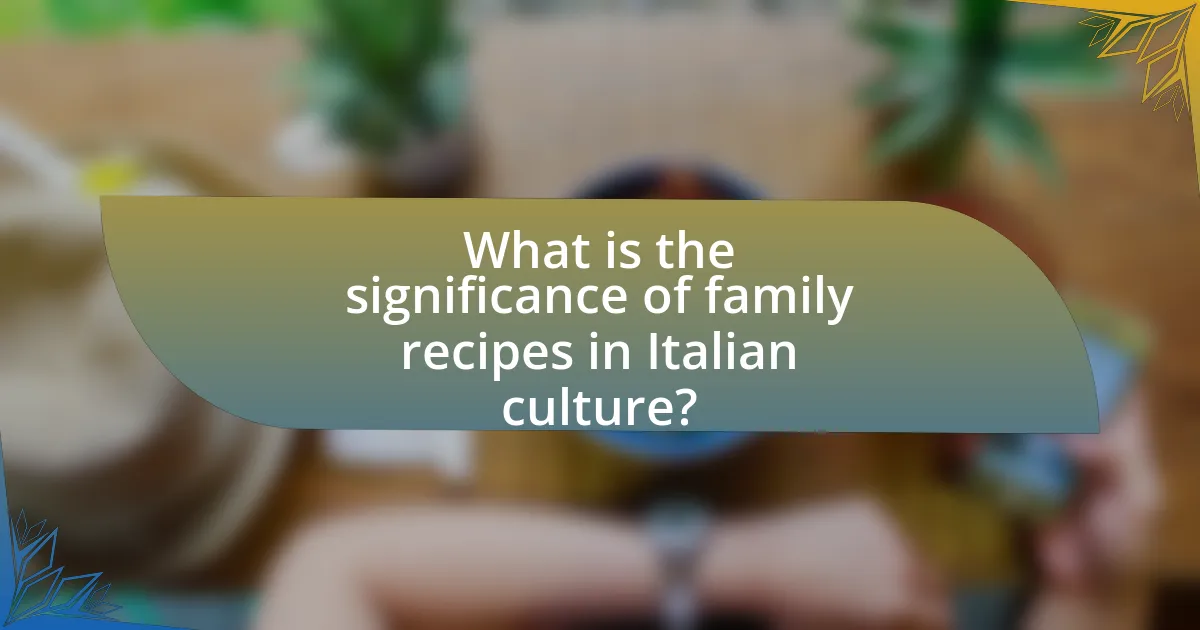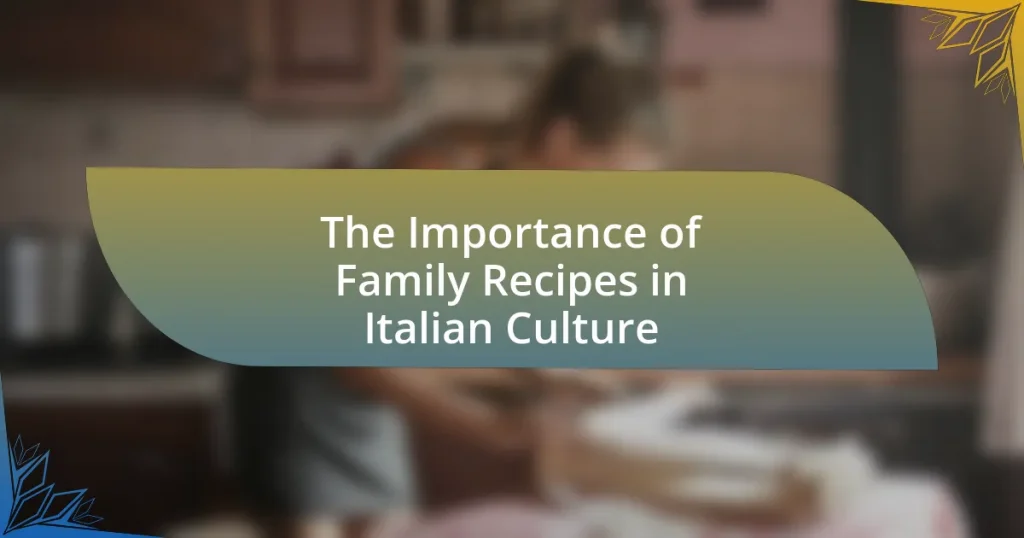Family recipes are a cornerstone of Italian culture, serving as vital links to culinary traditions and familial bonds. These recipes, often passed down through generations, reflect regional ingredients and cooking techniques that embody the history and identity of Italian families. The article explores the significance of family recipes in preserving cultural heritage, the role of ingredients and cooking methods across different regions, and the emotional connections families have with their culinary traditions. It also addresses the challenges of preserving these recipes in the face of globalization and changing dietary preferences, while offering strategies for documentation and adaptation to maintain their essence.

What is the significance of family recipes in Italian culture?
Family recipes hold significant cultural value in Italian culture as they serve as a means of preserving culinary traditions and familial bonds. These recipes are often passed down through generations, reflecting regional ingredients and cooking techniques that embody the history and identity of Italian families. For instance, a study by the University of Gastronomic Sciences highlights that family recipes not only foster a sense of belonging but also contribute to the continuity of cultural heritage, as they are often associated with family gatherings and celebrations. This intergenerational transmission of recipes reinforces social ties and cultural identity, making family recipes a vital aspect of Italian cultural life.
How do family recipes reflect Italian heritage?
Family recipes reflect Italian heritage by preserving traditional cooking methods and regional ingredients that have been passed down through generations. These recipes often embody the cultural values of family, community, and the importance of sharing meals, which are central to Italian life. For instance, dishes like pasta and risotto vary significantly across regions, showcasing local produce and culinary techniques, thus highlighting Italy’s diverse cultural landscape. Additionally, the act of preparing and sharing these recipes fosters familial bonds and reinforces a sense of identity, as families gather to celebrate their heritage through food.
What role do ingredients play in traditional Italian family recipes?
Ingredients are fundamental to traditional Italian family recipes as they define the authenticity and flavor profile of the dishes. Each ingredient, whether it be fresh tomatoes, high-quality olive oil, or aged cheese, contributes to the overall taste and cultural significance of the meal. For instance, the use of locally sourced ingredients reflects regional culinary traditions and family heritage, ensuring that recipes are passed down through generations with their unique characteristics intact. This emphasis on specific ingredients not only preserves the integrity of the dish but also fosters a sense of identity and belonging within Italian families, as meals are often tied to memories and familial bonds.
How do cooking methods vary across different Italian regions?
Cooking methods in Italy vary significantly across regions due to local ingredients, traditions, and historical influences. For instance, northern regions like Lombardy and Veneto often utilize techniques such as risotto preparation and polenta cooking, reflecting the abundance of rice and corn in these areas. In contrast, southern regions like Sicily and Calabria emphasize grilling and frying, influenced by the Mediterranean climate and the availability of fresh vegetables and seafood.
Additionally, the use of slow-cooking methods, such as braising, is prevalent in Tuscany, where hearty meats and vegetables are common. This regional diversity is rooted in Italy’s agricultural practices and cultural heritage, showcasing how family recipes are adapted to local resources and culinary traditions.
Why are family recipes considered a form of cultural identity?
Family recipes are considered a form of cultural identity because they encapsulate the traditions, values, and history of a community. These recipes often reflect regional ingredients, cooking techniques, and family stories that have been passed down through generations, serving as a tangible connection to one’s heritage. For instance, in Italian culture, specific dishes like lasagna or risotto are not just meals but represent familial bonds and regional pride, showcasing local customs and agricultural practices. This connection is reinforced by the fact that many families gather to prepare and share these recipes, fostering a sense of belonging and continuity within the cultural framework.
How do family recipes preserve historical narratives?
Family recipes preserve historical narratives by serving as tangible links to cultural heritage and familial traditions. These recipes often reflect the ingredients, cooking methods, and culinary practices that have been passed down through generations, encapsulating the social and historical contexts of their time. For instance, a recipe for a traditional Italian dish may reveal the influence of regional agricultural practices, migration patterns, and historical events, such as the availability of certain ingredients due to trade or war. Additionally, family recipes often carry personal stories and memories associated with family gatherings, celebrations, and rituals, further embedding historical narratives within the culinary practices of a community. This intergenerational transmission of knowledge not only maintains cultural identity but also fosters a sense of belonging and continuity among family members.
What emotional connections do families have with their recipes?
Families have deep emotional connections with their recipes, often viewing them as a means of preserving heritage and fostering unity. These recipes serve as a tangible link to family history, evoking memories of shared meals and celebrations that strengthen familial bonds. For instance, traditional Italian recipes passed down through generations not only reflect cultural identity but also create a sense of belonging and continuity. Research indicates that cooking and sharing meals can enhance emotional well-being, as families engage in storytelling and reminiscence while preparing these cherished dishes. This emotional significance is further underscored by the fact that 70% of individuals report feeling closer to their family when cooking together, highlighting the role of recipes in nurturing relationships.

How do family recipes contribute to family bonding?
Family recipes contribute to family bonding by creating shared experiences and fostering connections among family members. When families gather to prepare and enjoy traditional dishes, they engage in storytelling and cultural exchange, reinforcing their heritage. Research indicates that cooking together enhances communication and teamwork, which strengthens relationships. For example, a study published in the Journal of Family Psychology found that shared meals and cooking activities significantly improve family cohesion and emotional well-being. Thus, family recipes serve as a vital tool for nurturing bonds and preserving cultural identity within families.
In what ways do cooking together strengthen family ties?
Cooking together strengthens family ties by fostering communication, collaboration, and shared experiences. Engaging in the cooking process allows family members to interact, share stories, and bond over the preparation of meals, which can create lasting memories. Research indicates that families who cook together often report improved relationships and increased feelings of closeness. For instance, a study published in the Journal of Family Psychology found that shared meal preparation enhances family cohesion and promotes positive interactions among family members. This collaborative effort not only nurtures relationships but also instills cultural traditions, such as those found in Italian cuisine, where family recipes are passed down through generations, further solidifying familial bonds.
What traditions are associated with family meal preparation?
Family meal preparation in Italian culture is deeply rooted in traditions that emphasize communal cooking and the use of family recipes passed down through generations. These traditions often involve gathering family members to cook together, fostering a sense of unity and shared heritage. For instance, the practice of preparing pasta from scratch is a common family activity, where techniques and recipes are taught by older generations to younger ones, ensuring the preservation of culinary heritage. Additionally, specific meals are often associated with particular holidays or celebrations, such as preparing a feast for Christmas or Easter, which reinforces family bonds and cultural identity. This emphasis on collective cooking and the transmission of recipes highlights the importance of family meals in maintaining cultural traditions within Italian society.
How do family recipes facilitate storytelling during meals?
Family recipes facilitate storytelling during meals by serving as a tangible connection to heritage and shared experiences. When families gather to prepare and enjoy these recipes, they often recount the origins of the dishes, the memories associated with them, and the loved ones who passed them down. This practice not only preserves cultural traditions but also strengthens familial bonds, as evidenced by studies showing that shared meals enhance communication and relationship quality. In Italian culture, for instance, the act of cooking and sharing traditional recipes fosters a sense of belonging and continuity, allowing stories of past generations to be relived and celebrated at the dining table.
What impact do family recipes have on celebrations and gatherings?
Family recipes significantly enhance celebrations and gatherings by fostering a sense of tradition and connection among participants. These recipes often carry historical significance, reflecting cultural heritage and familial bonds that are passed down through generations. For instance, in Italian culture, dishes like lasagna or tiramisu are not just meals but symbols of family unity, often prepared during holidays and special occasions, reinforcing relationships and shared memories. Studies show that meals prepared from family recipes can evoke nostalgia and strengthen emotional ties, making gatherings more meaningful and memorable.
Which family recipes are most commonly associated with holidays?
Family recipes most commonly associated with holidays include lasagna, panettone, and roasted lamb. Lasagna is a traditional dish served during Christmas and Easter, symbolizing family gatherings and abundance. Panettone, a sweet bread loaf, is a staple dessert during the Christmas season, originating from Milan and often shared among families. Roasted lamb is frequently prepared for Easter celebrations, representing renewal and tradition in Italian culture. These recipes not only reflect culinary heritage but also reinforce familial bonds during festive occasions.
How do family recipes evolve during significant life events?
Family recipes evolve during significant life events by incorporating new ingredients, techniques, or traditions that reflect the changes in family dynamics and cultural influences. For instance, weddings often introduce new dishes from a spouse’s heritage, while births may lead to the creation of celebratory recipes that honor the new family member. These adaptations not only preserve the original recipes but also create a living history that connects generations. Research indicates that food traditions are often modified to accommodate dietary restrictions or preferences, further illustrating how recipes adapt to the evolving needs of the family.

What challenges do families face in preserving their recipes?
Families face several challenges in preserving their recipes, including loss of knowledge due to generational gaps, lack of documentation, and changing food preferences. The passing down of culinary traditions often relies on oral transmission, which can lead to incomplete or forgotten recipes as older generations pass away. Additionally, many families do not document their recipes, resulting in a reliance on memory that can be unreliable. Changing dietary habits and preferences, influenced by modern lifestyles and health trends, can also lead to the abandonment of traditional recipes, further complicating preservation efforts. These factors collectively threaten the continuity of family culinary heritage, particularly in cultures where food plays a significant role in identity, such as Italian culture.
How does globalization affect traditional Italian family recipes?
Globalization significantly influences traditional Italian family recipes by introducing diverse ingredients and culinary techniques from around the world. This exposure leads to the adaptation and fusion of traditional recipes, as families incorporate international flavors and cooking styles into their meals. For instance, the rise of global food trends has resulted in the blending of Italian cuisine with Asian or Latin American elements, creating hybrid dishes that may deviate from authentic recipes. Additionally, the accessibility of international ingredients through global supply chains allows Italian families to experiment with new flavors, which can alter the traditional cooking practices passed down through generations. This phenomenon reflects a broader trend where cultural exchange reshapes culinary identities, as seen in the increasing popularity of dishes like sushi pizza or pasta with Asian-inspired sauces.
What are the risks of losing authenticity in family recipes?
Losing authenticity in family recipes risks erasing cultural heritage and personal identity. When traditional ingredients and methods are altered or replaced, the unique flavors and stories tied to those recipes diminish, leading to a homogenization of culinary practices. This loss can result in a disconnection from family history and traditions, as recipes often serve as a means of preserving familial bonds and cultural narratives. Studies show that food is a significant aspect of cultural identity; for instance, research by the University of Gastronomic Sciences highlights how traditional recipes contribute to community cohesion and cultural continuity. Therefore, the risks include not only the dilution of taste but also the potential loss of cultural significance and familial connections.
How can families adapt recipes while maintaining their essence?
Families can adapt recipes while maintaining their essence by focusing on key ingredients and traditional cooking methods. By substituting similar ingredients that retain the original flavor profile, such as using whole grains instead of refined ones, families can keep the dish’s core characteristics intact. Additionally, preserving the cooking techniques, like slow simmering or roasting, ensures that the dish reflects its cultural roots. Research shows that maintaining these elements helps in retaining the emotional and cultural significance of family recipes, which are central to Italian culinary traditions.
What strategies can families use to preserve their culinary heritage?
Families can preserve their culinary heritage by documenting recipes, engaging in regular cooking sessions, and passing down cooking techniques through generations. Documenting recipes in a family cookbook or digital format ensures that traditional dishes are recorded accurately for future generations. Regular cooking sessions, where family members gather to prepare traditional meals, reinforce cultural practices and create shared experiences. Additionally, teaching younger family members specific cooking techniques and the stories behind each dish fosters a deeper appreciation for their culinary heritage. These strategies are effective as they create a tangible connection to cultural identity and ensure that culinary traditions are maintained over time.
How can technology assist in documenting family recipes?
Technology can assist in documenting family recipes by providing digital platforms for storage, sharing, and organization. Applications like recipe management software and cloud storage services allow families to easily input, categorize, and access their recipes from various devices. Furthermore, multimedia tools enable the inclusion of photos and videos, enhancing the documentation process and preserving the visual aspects of cooking. Research indicates that 70% of families prefer using digital formats for recipe sharing, highlighting the effectiveness of technology in maintaining culinary traditions.
What role do cookbooks and food blogs play in recipe preservation?
Cookbooks and food blogs serve a crucial role in recipe preservation by documenting and sharing culinary traditions, ensuring that family recipes are passed down through generations. Cookbooks compile a wide range of recipes, often including historical context and personal anecdotes that enrich the understanding of the dishes, while food blogs provide a dynamic platform for sharing contemporary interpretations and adaptations of traditional recipes. According to a study published in the Journal of Culinary Science & Technology, the digitalization of recipes through blogs has increased accessibility and engagement, allowing for a broader audience to connect with cultural heritage. This combination of written and digital formats helps maintain the relevance of family recipes in Italian culture, fostering a sense of identity and continuity.
What are some practical tips for creating and sharing family recipes?
To create and share family recipes effectively, document each recipe with clear ingredients and step-by-step instructions. This ensures consistency and makes it easier for others to replicate the dish. Additionally, consider including personal anecdotes or historical context related to the recipe, as this enriches the sharing experience and preserves family heritage. Sharing can be done through printed recipe cards, digital formats like blogs or social media, or family gatherings where dishes are prepared together, fostering connection and tradition.















